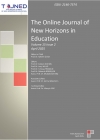TOJNED - Volume 10 - Issue 2 - April 2020
 A COMPARISON OF COMPUTER BASED TESTING AND PAPER AND PENCIL TESTING IN MATHEMATICS ASSESSMENT
A COMPARISON OF COMPUTER BASED TESTING AND PAPER AND PENCIL TESTING IN MATHEMATICS ASSESSMENT Tara McClelland, Josh Cuevas
Abstract:
Today’s schools turn to computers for all aspects of learning, including assessment. While advantages to computer testing do exist, the comparability between paper pencil tests (PPT) and computer-based tests (CBT) must be considered. This study examined whether the testing medium impacts student performance in math assessment by addressing three questions. First, does a test mode effect exist, as evidenced by mean score difference between a CBT and a PPT? Second, does question type: multiple choice, constructed response, or extended response, relate to student performance? Third, does either gender or computer experience and familiarity impact CBT and PPT scores? Eighty 6th grade students took math tests with half of the questions on a PPT and half of the questions on a CBT. A computer familiarity survey was completed prior to the unit tests. Significant differences were found for one of the unit tests and for some of the question types.
 IMPROVISATION IN LEADERSHIP EDUCATION: “MAKING INTERACTIONS WITH OTHERS MORE POSITIVE AND MEANINGFUL”
IMPROVISATION IN LEADERSHIP EDUCATION: “MAKING INTERACTIONS WITH OTHERS MORE POSITIVE AND MEANINGFUL” Nicole A. Buras, Bob Kulhan
Abstract:
Improvisation is synonymous with unplanned performances. Paradoxically, successfully engaging in improvisation involves structured underlying techniques. These structured elements have transferable applications to leadership and organizational development. The purpose of this research project is to explore students’ experiences engaging in improvisation during a weeklong graduate course. We employed a basic interpretive qualitative approach to examine learners' perceptions around the applications of improvisation tenets and strategies to their professional lives. Results from this study highlighted that the use of the improvisational tenet yes, and motivated participants moving beyond a personal agenda to promote collaboration. Improvisation also facilitated the assessment and mindful adjustment of energy to inspire authentic engagement with others to build trust. Additionally, learners embraced spontaneity to hone their ability to adapt and react in time to change.
 INTEGRATING LIVE CODING AND INTERACTIVE SYLLABUS TO ENGAGE STUDENTS IN AN INTERACTIVE MEDIA ARTS COURSE
INTEGRATING LIVE CODING AND INTERACTIVE SYLLABUS TO ENGAGE STUDENTS IN AN INTERACTIVE MEDIA ARTS COURSE Aven Le Zhou, Jace Hargis
Abstract:
Teaching coding to a diverse group of students has several major challenges. This paper will suggest two major teaching methodologies that had been shown to be effective in addressing many of the challenges at three small international liberal arts colleges. The teaching techniques used included a Live Coding and Interactive Syllabus. Findings included positive student dispositions during and after the use of the two methodologies; and more meaningful use of coding and discipline specific vocabulary by students. The authors will continue to implement the methods, collect data and further analyze the results in an on-going continuous improvement approach to effective teaching.
 LEARNING IN FINANCIAL BEHAVIOR CASE STUDY IN INDONESIA
LEARNING IN FINANCIAL BEHAVIOR CASE STUDY IN INDONESIA Agung Listiadi
Abstract:
Learning in higher education has an important role in shaping student financial behavior. Where in the learning done one acquires knowledge which can then be practiced on daily behavior. Financial literacy plays an important role in guiding disciplinary behavior can be a supporting attitude of each individual in meeting the budget or planning that has been made in managing finances. This can be interpreted that discipline is one of self-control in terms of financial management This research is a quantitative study using the ex-post facto method. Respondents in this study were 100 students. The data collection methods used are questionnaires and tests. While the data analysis technique used is multiple linear regression analysis. The results of this study indicate that learning financial accounting, financial literacy and self-control simultaneously have a significant effect on financial behavior, financial accounting learning has a significant effect on financial behavior, financial literacy, has a significant effect on financial behavior, self-control has a significant effect on financial behavior.
 THE EFFECTIVENESS OF DESIGN THINKING AND COLLABORATION ON EDUCATORS’ INTERNSHIP
THE EFFECTIVENESS OF DESIGN THINKING AND COLLABORATION ON EDUCATORS’ INTERNSHIP SOUNOGLOU MARINA
Abstract:
In the present study investigated whether the adopting strategy "design thinking” has benefited the effectiveness of prospective teachers by developing cross-curricular work plans and educational action plans during their internships. The sample is comprised of 20 pre-service teachers of the 4th year students in the Faculty of Early Childhood Education Science, in Greece during the academic year 2017-2018. The methodology that was followed was the qualitative analysis of the discourse in the submitted minutes of the students' activities and assessments that coded the concept of “design thinking” and “creative collaboration”. The conclusions indicate that the pre-service teachers believe that they have developed the design thinking, the creative collaboration during the implementation of the work plans through discussion, teamwork, collective planning, implementation and collective reflection feedback on work plans.
 VALUE ORIENTATION AND JOB EFFECTIVENESS OF NEW ACADEMIC STAFF OF PUBLIC UNVERSITIES IN NORTH-CENTRAL NIGERIA
VALUE ORIENTATION AND JOB EFFECTIVENESS OF NEW ACADEMIC STAFF OF PUBLIC UNVERSITIES IN NORTH-CENTRAL NIGERIA Setka G. Walbe
Abstract:
The study examined the extent of value orientation programmes on the performance of lecturers in public Universities in North-central, Nigeria. The study was precipitated by perpetually observed problems of weak University culture and the constant poor job effectiveness of most teaching staff in public Universities in North-Central Nigeria. Most of them are unhappy and uninspired with the unconducive working environment. The lack of good working condition has no doubt, translated into poor pedagogy, lack of commitment and dedication to duty, poor feedback to students, reduced levels of research outcomes and community service with resultant effect on students’ performance and University’s goals attainment. The conduct of induction training is often justified for its purpose to help new employees to fit smoothly into an organization. The research design adopted for this study was the descriptive survey method. The population of this study consists of all the seven thousand seven hundred and forty seven (7747) academic staff members and two hundred and fifty three thousand eight hundred and seventy two (253872) students working and studying in the thirteen public Universities and the Federal Capital Territory in North-central Nigeria
The sample of 501 lecturers and 2363 students from six public Universities was used. This was based on the Yamene (1967) formula for sampling. Data was collected using the ‘Value Orientation Programmes and Job Effectiveness of New Academic Staff’ Questionnaire (VOPJENASQ) for lecturers and Academic Staff Effectiveness Questionnaire (ASEQ) for students. Mean, Standard Deviation were used to answer the research questions while Pearson Correlation was used to test the hypothesis at 0.05 level of significance. The result showed that there is significant relationship between job effectiveness of lecturers and value orientation programmes in public Universities in North-central Nigeria. The findings also revealed that value orientation programmes for new academic staff members have a positive influence on job effectiveness of lecturers. Thus, in order for new academics to be effective in their job duties, administrators should encourage value orientation programmes for new academic staff to stabilize them in their new job challenges by designing induction programmes and guidelines for job effectiveness and University goal achievement. Senior academics should not only be concerned with administrative, teaching and supervisor/supervisee relationship, they should be made by policy and insist they share time, skills, knowledge and competences to new staff members as a necessary means of handing over professionalism.


